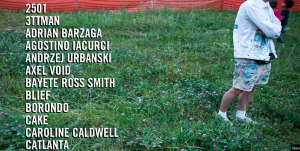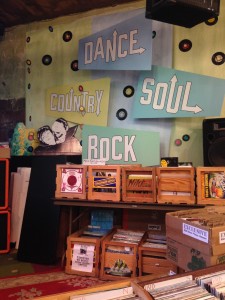Communal Differences: Virginia-Highlands v. Little Five Points
While strolling down the stained sidewalks of Little Five Points, drum beats played on turned over buckets pulse through the streets, the smell of street food fills the air, and an array of people explore the eclectic retail district. On the contrary, on the streets of Virginia Highlands there is a certain stillness. Other than the sound of cars passing by, the area has peacefulness to it. The restaurants are more uniform and so is the community. Surrounding the shops and restaurants are suburban homes with front porch swings and minivans. These two areas are in close proximity, but differ greatly. The built environments of Little Five Points and Virginia Highlands shape and are shaped by different groups of people due to differences in the historical foundation of the spaces, the layout of the streets, and the location of these neighborhoods in proximity to other influential spaces in Atlanta.
Historical Foundation
An area’s historical background influences how the built environment of that space develops as time progresses. Since the late 1960’s, Little Five Points has been known for its odd knick-knack shops, antiques, and discount clothing (Wheatley). Even back then people knew they could go to Little Five Points to save money on picture shows, clothing, and other goods. It is interesting to see how that trend has stayed with and developed the area over the last fifty years. Because the neighborhood’s roots are deep into the eclectic culture of city living and freedom of expression, the area has not developed into anything more than just that. Because it has been “known for” a certain type of merchandise and culture, this image has shaped the built environment a great deal and stayed with the space for many years. Even today, Atlantans know they can go to Little Five Points and come back with a funky new pair of sunglasses and a stomach full of cheap (but delicious) food.
As for Virginia-Highlands, even back in the 1960’s the area began transforming into a family-oriented, upscale neighborhood (Virginia-Highland: A Rich History). Young professionals and families began moving into the area and renovating old homes and utilitarian storefronts into boutiques and restaurants. The area transformed into a city-walk with a suburban feel, well equipped with parks and excellent schools. What really drew the community in close was the announcement that a major highway, I-485, would run right through the beautiful neighborhood, disrupting what the community had created and destroying hundreds of homes. A group of civilians decided to fight back and formed the Virginia-Highland Civic Association; the group was successful in putting a stop to the highway plans (Virginia-Highland: A Rich History). A group like this taking shape within a built environment build a foundation for a strong community and a “work together” attitude. The Virginia-Highland Civic Association is still an active group within the neighborhood to this day. Even fifty years ago, Little Five Points and Virginia-Highlands began to differ in community, which in turn transformed both neighborhoods into unique areas.
Neighborhood Layout
The layout of both neighborhoods is different in many ways, but each serves a purpose for the built environment and caters to the community. In Little Five Points, there is one large communal area in the center of the neighborhood, known as Findley Plaza. All the restaurants and shops surround the large area, which is equipped with benches, trees, and always filled with street musicians. Compared to Virginia-Highlands, Little Five Points is smaller and although there are residential homes, they are not really included in to the main retail area of the space. This can be seen from the photograph shown below: the communal area allows for a “hang out” spot for those strolling around the area, while the homes are located in a different part of the neighborhood.
This type of built environment accommodates a younger, more social crowd. The central area provides groups a space to spread out and socialize. This spot is always a meeting place in Little Five Points. There are friends embracing and then going on their way to explore the remainder of the eclectic neighborhood, street musicians jamming on various instruments, and pedestrians walking their dogs. Branching off from Findley Plaza is the main street, Euclid Avenue, where all the funky shops and restaurants are located. Below is a screenshot of a map of Little Five Points that shows how Findley Plaza is the common area within the retail area of Little Five Points.
The layout of the built environment in Virginia-Highlands differs greatly from that of Little Five Points. The major retail strips are directly across from the residential areas. This aspect of the layout shows how the area is more family-oriented, which is why the retail area is more reserved and quiet. When I visited Virginia-Highlands for my exterior built environment description I noticed that the aural characteristics of the space were very quiet; here is one of my sound recordings (Hegner). Out on the street the only noises to be heard were cars passing by and an occasional dog barking. There are no street musicians, loud chatter, or boisterous music filling the air in Virginia-Highlands.
There is a certain calm in this area during the day, which I think has to do with the layout of the neighborhood. The residential area surrounding the shops is one reason why the area is much more composed; another reason for this is the parks located in Virginia-Highlands. In one of the major retail spots, North Highland Park is across the street from the retail area. To be able to walk out of a restaurant or coffee shop and cross the street to a peaceful park is a major characteristic of this built environment. Parks take away from the hustle and bustle of the city and influence the area in a positive way. A screenshot of the park mentioned is pictured below, which shows how it is surrounded by shops and homes.
Influential Surrounding Areas
The areas that surround a neighborhood influence the type of community that settles there and overall help shape the built environment. The neighborhoods surrounding Virginia-Highlands are Midtown, Druid Hills, and Ansley Park, which are all upper to middle class areas. The areas surrounding Little Five Points include Old Fourth Ward, Edgewood, and Downtown, all of which consist of a middle to lower class population and vary more racially. One major influence of an area’s built environment is household income. The average household income changes drastically when going from Little Five Points to Virginia-Highlands. For instance, the average income in Little Five Points ranges from $66,000 to $76,000. Whereas in Virginia-Highlands this span is more like $109,000 to $128,000 (City Data). With the income being almost double this, the Virginia-Highlands draws in a more family oriented, upscale community. This may just sound like a matter of real estate, but household income trickles down to the types of shops and restaurants built in the area, the upkeep of the streets and sidewalks, and the type of community that settles in that particular built environment.
As for Little Five Points, the neighborhood has a significantly lower household income and this can be seen by observing the built environment. The used goods, vintage apparel shops, and thrifty stores are an indicator of a whole different community that has taken root (Lydia Bohanan). The shops would not be there if the population of Little Five did not frequent them. For instance, the new designer shops in Buckhead that were recently built would not be seen in an area like Little Five Points. These shops would quickly go out of business because the type of clientele that they cater to does not reside in Little Five. The retail district of a neighborhood adapts to the type of people that reside there, and overall their income as well. Therefore, the areas surrounding these to spots have some effect on the type of community and how the built environment adapts.
Overall, when observing the built environment of a neighborhood there is so much more to it than meets the eye. Before I researched these two places, they were merely two neighborhoods I drove through on occasion while exploring Atlanta. Now after exploring them in full, I can say with confidence that Little Five Points and Virginia Highlands are different in so many ways, despite the less than two mile difference between them. That is another interesting component that comes into play, Little Five Points and Virginia Highlands are within such close proximity, but differ greatly. That is the beauty of the built environment of a city, you can can walk two miles down the road and experience a whole new atmosphere. This all has to do with the historical foundation that the neighborhoods were built on, the layout of the streets and attractions, and the surrounding places. All three of these factors shape and cause a certain crowd to gather and settle, which in turn forms the type of housing, shops, restaurants, and communal areas that shape an area’s built environment.
Works Cited
“Atlanta, Georgia (GA) Income Map, Earnings Map, and Wages Data.” City Data. Accessed April 26, 2016. http://www.city-data.com/income/income-Atlanta-Georgia.html.
Thomas Wheatley. “How Did Little Five Points Get Weird?” Newspaper. Creative Loafing Atlanta. Accessed April 19, 2016. http://clatl.com/atlanta/how-did-little-five-points-get-weird/Content?oid=17069654.














